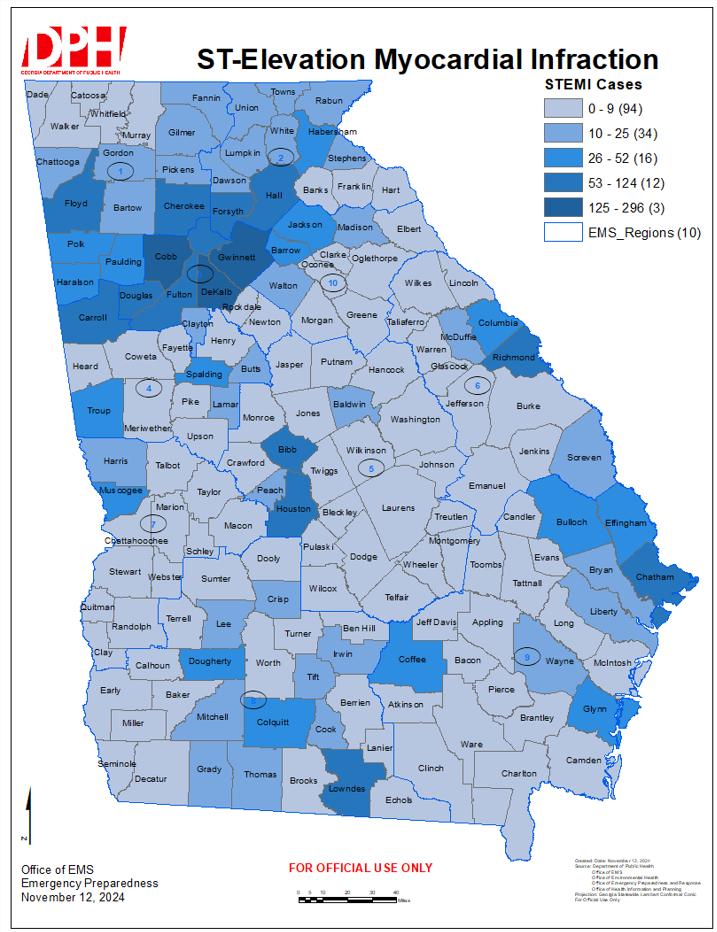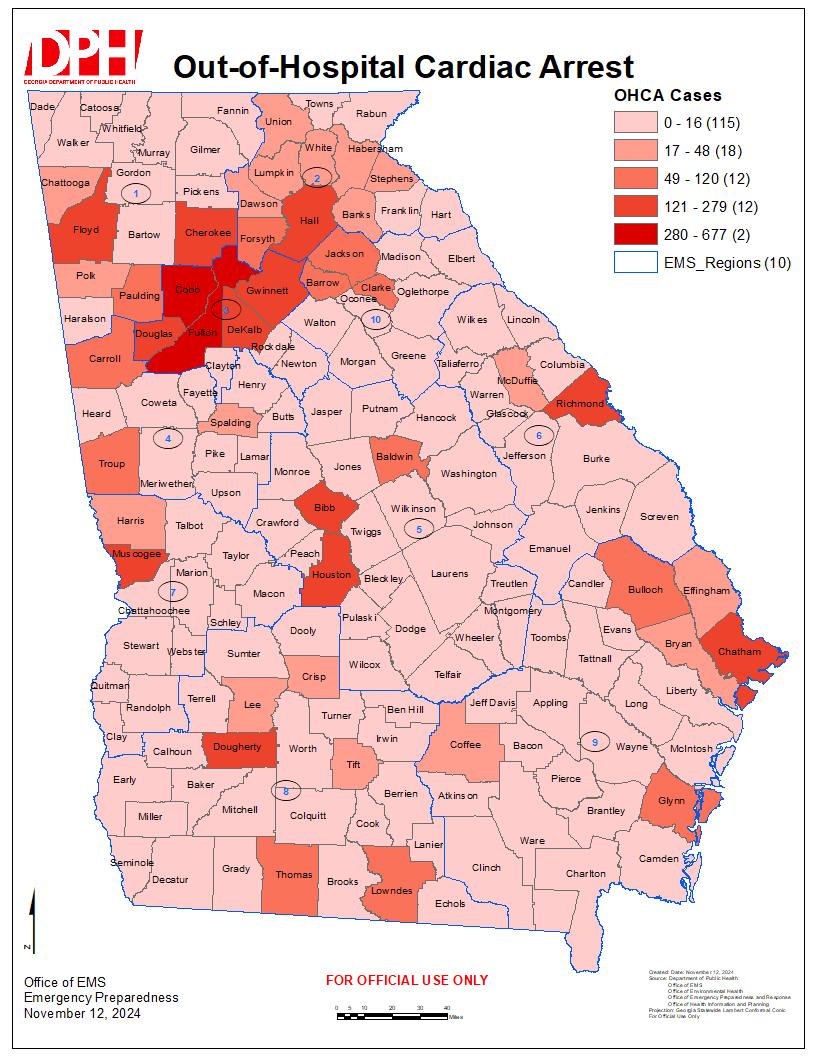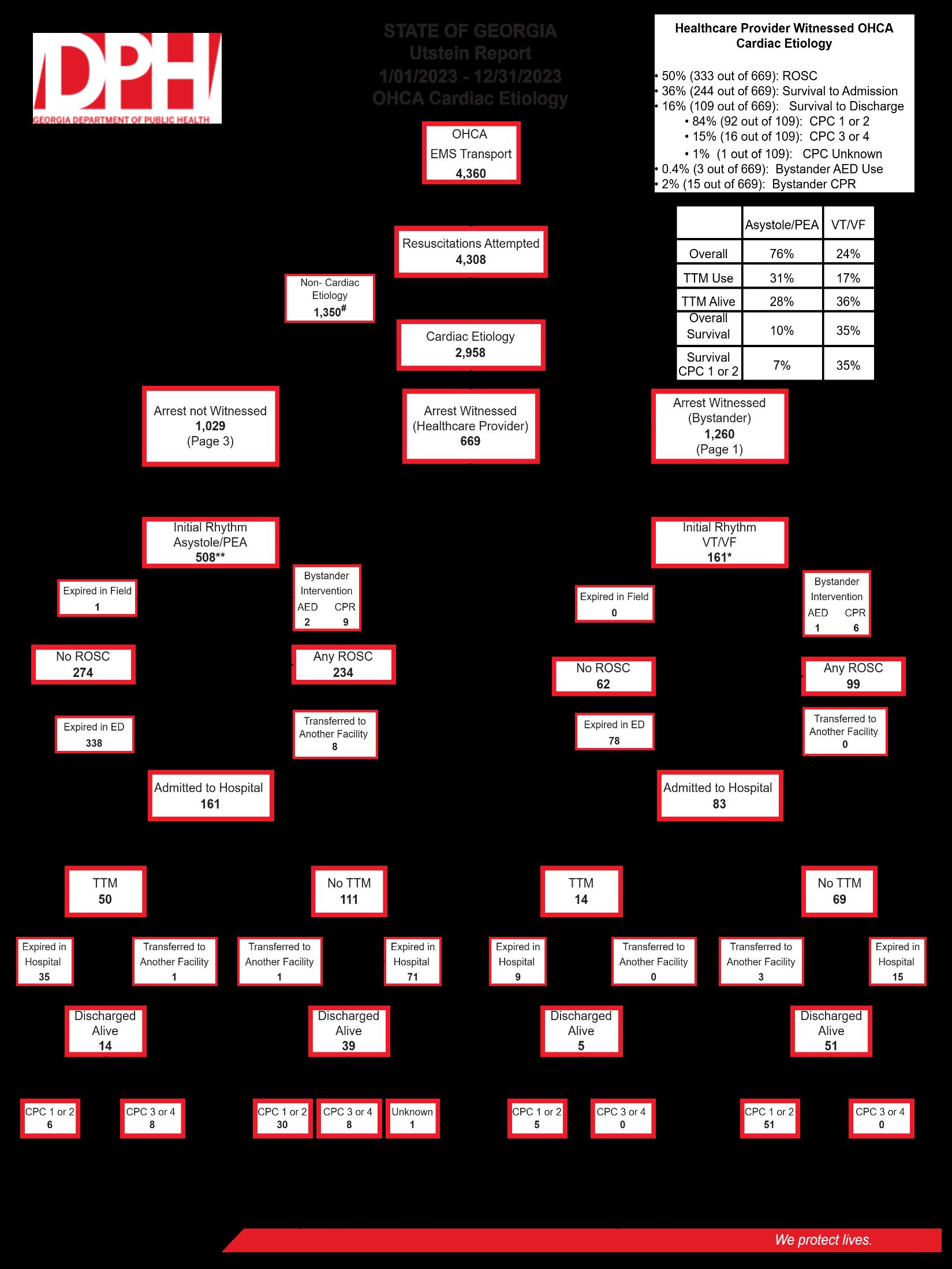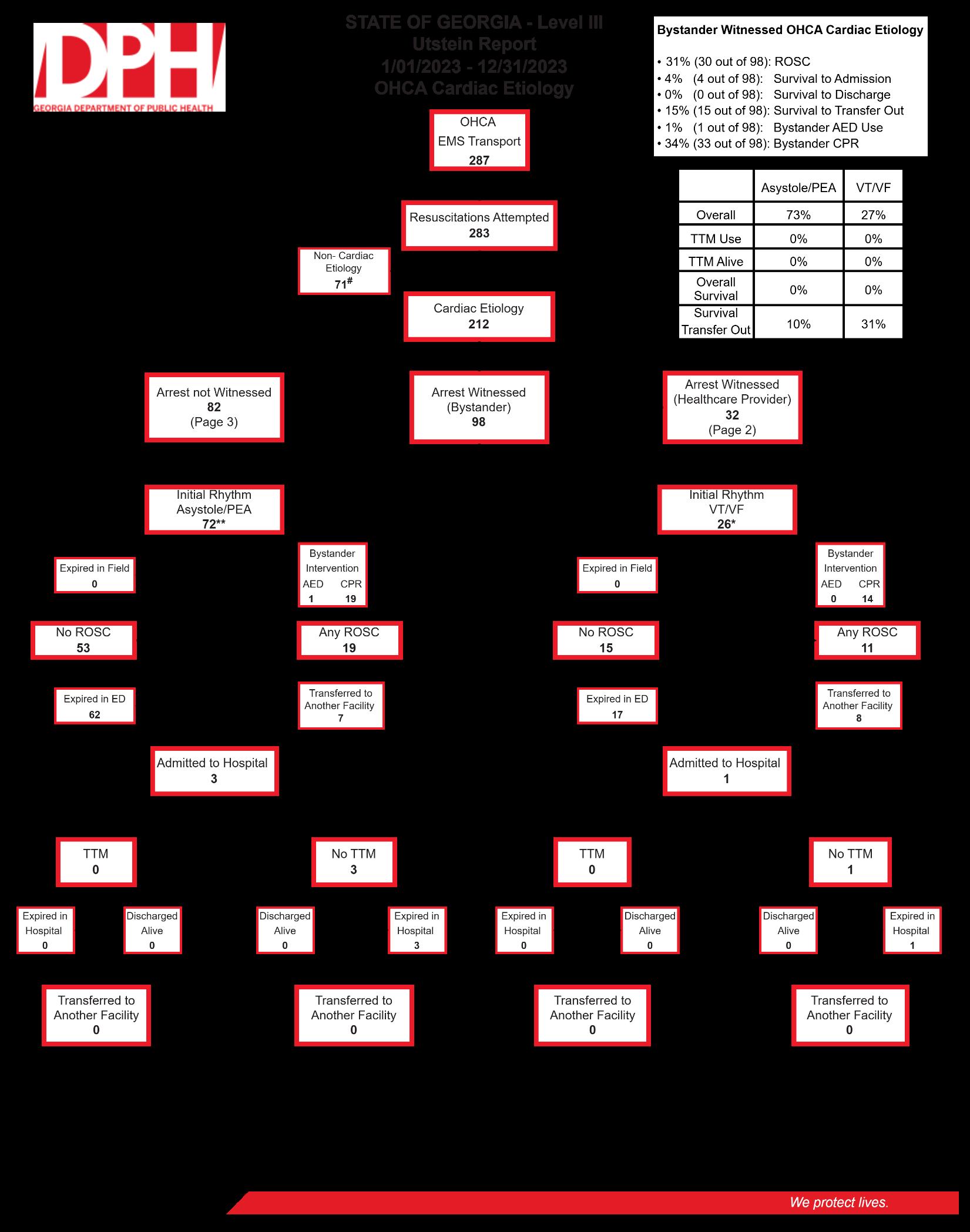Georgia Emergency Cardiac Care Annual Report
Time Critical Diagnosis – STEMI and OHCA

“Alone we can do so little; Together we can do so much!”


“Alone we can do so little; Together we can do so much!”





Michael Johnson
Director, Office of EMS and Trauma
April Moss
Deputy Director, Systems of Care
Tiffany Harris
Cardiac Epidemiologist, Office of Cardiac Care
Maureen Frazier
GCaR Administrator, Office of Cardiac Care
Juana Smith
Business Administrator, Systems of Care
Cardiovascular disease is responsible for over 800,000 deaths each year in the U.S., or about one in three deaths, according to the American Heart Association. Each day, 2,300 Americans die from cardiovascular disease. To improve these outcomes and reduce the death burden from cardiovascular disease and out-of-hospital cardiac arrest (OHCA) in Georgia, legislation was signed into law in 2017 establishing the Office of Cardiac Care within the Georgia Department of Public Health.
The Mission of the Office of Cardiac Care is to improve survival rates in Georgia for out-of-hospital cardiac arrests (OHCA) and heart attacks (STEMI) through quality improvement, benchmarking and evidence-based guidelines. This effort is supported by a standardized data collection and reporting system. The foundation for evaluating Georgia’s Emergency Cardiac Care System is the establishment and maintenance of the Georgia Cardiac Registry (GCaR)
The Emergency Cardiac Care System is a voluntary system comprised of several separate components, which are organized and work together, as a system. The individual components and elements are described below:
• EMS Regions –Facilitates system organization, coordination, and education requirements for both practitioners and the public. Each EMS Region (1-10) has a regional Emergency Cardiac Care Coordinator (ECCC) responsible for scheduling and facilitating quarterly regional meetings.
• Pre-Hospital – EMS units are an integral part of the Emergency Cardiac Care System. All EMTs and Paramedics must have a basic understanding of the System Plan, including alert criteria for identifying STEMI and communication protocols
• Hospital – Hospitals may participate in the Emergency Cardiac Care System on a voluntary basis, but must meet the criteria prescribed by the Office of Cardiac Care, Department of Public Health.
• Regulatory Authority & Oversight – The Georgia Department of Public Health, Division of Health Protection, Office of Cardiac Care provides regulatory oversight and program management.
• Know what cardiac resources hospitals have, and they will be able to get patients to the right treatment in time.
• Strengthen Georgia’s Emergency Medical Services system.
• Ensure cardiac patients get the proper treatment needed
• Save lives, reduce disability, and improve quality of life.
• Have a designated Emergency Cardiac Care Center nearby.
• Have peace of mind knowing that if they go to the hospital, they’ll receive the correct treatment. In some cases, that will involve transferring patients to higher-level care. In other cases, EMS will take patients directly to another hospital.















Each system of care has five key components: an organizational structure, protocols for the transport and transfer of patients, an advisory group process, a performance/quality improvement process, and a data collection system. These components work together to accomplish the ultimate goal of the systems – to deliver the right patient to the right hospital the first time.
STEMI patients should be recognized as quickly as possible to identify those eligible for thrombolytic or primary PCI therapy. Research has shown that both morbidity and mortality can be reduced by the approach of rapid interventional reperfusion within ninety (90) minutes of first medical contact
Additional research has demonstrated that in-the-field recognition by pre-hospital providers utilizing 12-lead ECG, coupled with pre-hospital notification to the receiving facilities, can further reduce time to reperfusion, resulting in improved outcomes.
Performance Improvement is a vital part of the Emergency Cardiac System of Care. It is used to document continuing proper function of the system and evaluation of that function to implement improvements in system operation and Emergency Cardiac patient management.
Emergency Cardiac Care Centers submit data on STEMI and OHCA patients into the Georgia Cardiac Registry (GCaR) for use in performance improvement processes.
*Percutaneous Coronary Intervention (PCI) - Procedure used to open or widen narrowed or blocked blood vessels to restore blood flow supplying the heart. A small balloon on a catheter is delivered through the system of blood vessels into the area of blockage in the heart and then inflated to open the blocked artery. Devices such as a stent may be subsequently deployed at the blockage site to help keep the area from closing up again.
*Reperfusion - The process of restoring normal blood flow to an organ or tissue that has had its blood supply cut off, such as after a myocardial infarction.
• AdventHealth Redmond
• Atrium Health Navicent-Macon
• Augusta University Medical Center
• Emory Saint Joseph's Hospital
• Emory University Hospital
• Emory University Hospital Midtown
• Grady Memorial Hospital
• Memorial Health University Medical Center
• Northeast Georgia Medical Center-Gainesville
• Northside Hospital Gwinnett
• Phoebe Putney Memorial
• Piedmont Augusta
• Piedmont Macon
• St. Francis-Emory Healthcare
• St. Joseph's Hospital
• Wellstar Kennestone Regional Medical Center
• Atrium Health Floyd
• Coffee Regional Medical Center
• East GA Regional Medical Center
• Emory Johns Creek Hospital
• Houston Healthcare - Warner Robins
• John D. Archbold Memorial Hospital
• Northeast Georgia Medical Center – Braselton
• Northside Hospital Atlanta
• Northside Hospital Cherokee
• Northside Forsyth
• Atrium Health Navicent Baldwin
• Crisp Regional Hospital
• Effingham Health System
• Houston Healthcare - Perry
• Southeast Georgia Health System-Brunswick
• Tanner Medical Center - Carrollton
• Tanner Medical Center - Villa Rica
• Tift Regional Medical Center
• Wellstar Cobb Hospital
• Wellstar Douglas Hospital
• Wellstar North Fulton Hospital
• Wellstar Paulding Hospital
• Wellstar West GA Medical Center
• Northeast Georgia Medical Center-Barrow
• Northeast Georgia Medical Center-Lumpkin
• Northside Hospital Duluth
• Union General Hospital

43 designated emergency cardiac care centers submitted data in 2023.
o 16 Level I centers
o 19 Level II centers
o 8 Level III centers.
Note:
The data presented in this report is ONLY from designated Emergency Cardiac Care Centers in the year 2023.
Figures 1A, 1B, and 1C display the incidents for STEMI, OHCA, and Cardiogenic Shock by age and gender. In each figure, the frequency of incidents initially peak in ages 60-69, then decreases in ages 70-79 and above.
• Incidents are 73% in the male population and 27% in the female population for STEMI, Figure 1A.
• Inidents are 61% in the male population and 39% in the female population for OHCA, Figure 1B.
• Incidents are 71% in the male population and 29% in the female population for Cardiogenic Shock, Figure 1C.
African Americans experience the highest incidence of OHCA events compared to individuals of other races and ethnicities. Conversely, individuals classified as 'Other' have the highest incidence of STEMI compared to African Americans.
*Other contains Non-Hispanic Native Hawaiian or Other Pacific Islander, Non-Hispanic American India or Alaska Native, Non-Hispanic Multirace, and Non-Hispanic Asian.
Most of the STEMI patients treated by designated facilities had some form of private insurance, 34%. The next most common had a combination of insurance, 30%. (i.e. HMO & Medicare or State-Specific & PPO)
The overall mortality rate for STEMI patients at designated facilities is 7%, Table 1A. The overall mortality rate for OHCA patients at designated facilties is 84%, Table 1B. The overall mortality rate for Cardiogenic Shock patients at designated facilties is 33%, Table 1C.
Table 1A: STEMI Patients, Case Mortality Rates
Table 1B: OHCA Patients, Case Mortality Rates
Table 1C: Cardiogenic Shock Patients, Case Mortality Rates
• Two out of five STEMI patients admitted were current smokers or recent smokers.
• Smokers account for 37% of female STEMI patients and 41% of male STEMI patients.
• Cholesterol levels: 76% of admitted STEMI patients had levels below 200 mg/dL, while 8% had levels of 240 mg/dL or higher.
• Among patients with cholesterol levels of 240 mg/dL or higher:
o 69% were male
o 31% were female
Table 2A: OHCA Incidents
2B: STEMI Incidents
Of those transported to designated
About 96% of STEMI patients were centers, the majority (56%) were taken treated in a Level I or Level II designated to level I centers. centers.
This ch art represents the overall count of inc idents by facility designation level. While there are more Level II facilities, Level I facilities had the most incidents.
CASE CRITERIA:
Patients who meet the case criteria for the Georgia Cardiac Registry (GCaR) have the principal final/discharge diagnosis of a confirmed ST Elevation Myocardial Infarction (STEMI), should be included in the GCaR. This includes patients who are first treated at an Emergency Cardiac Care Center (ECCC) or transferred to an Emergency Cardiac Care Center within 24 hours of arriving at the transferring hospital. GCaR does not collect data for non-ST-elevation Myocardial Infarction (NSTEMI) diagnosis.
INCLUSION CRITERIA:
Patients with a confirmed diagnosis of STEMI who present to the hospital with signs, symptoms, or complaints consistent with an Acute Myocardial Infarction (AMI) (e.g., chest pain, tightness in chest, shortness of breath).
STEMI should be confirmed by:
• 12-Lead ECG results indicating AMI, or
• Elevated Troponin I levels above the upper normal limit
• Patients treated or evaluated for a STEMI, even if they later transfer, leave against medical advice, or expire
• Patients directly transported to a catheterization laboratory or other nursing unit for STEMI treatment.
• Patients with STEMI who refuse treatment or have Do Not Resuscitate (DNR) orders.
ICD-10 CM DIAGNOSIS CODES TO INCLUDE:
ICD-10-CM codes used to describe the diagnosis of ST Elevation Myocardial Infarction (STEMI).
• I21: Acute myocardial infarction (including Type 1 myocardial infarction):
• I21.1: ST elevation (STEMI) myocardial infarction of inferior wall
• I21.2: ST elevation (STEMI) myocardial infarction of other sites
• I21.3: ST elevation (STEMI) myocardial infarction of unspecified site
EXCLUSION CRITERIA:
Patients are excluded from GCaR if they meet any of the following criteria:
• Under 18 years of age
• Transferred more than 24 hours after arrival at the initial hospital
• Present to an ECCC for non-STEMI symptoms (e.g., a patient evaluated for an ankle fracture later diagnosed with STEMI)
• Have ECG results stating "old" or "suspected MI" without positive cardiac markers
• Transferred to an ECCC for reasons unrelated to acute MI care (e.g., CABG or insurance-related transfers)

This heat map depicts STEMI patients’ county of residence from GCaR in 2023. 8% were patients with out of state home counties.
It is recommended that patients experiencing cardiac emergencies be transported to hospitals via Emergency Medical Services (EMS), as EMS serves as the first point of medical contact. EMS providers can identify STEMI cases and administer critical interventions during transport Patients should be taken directly to the closest and most appropriate center. The tables and graphs in this section present data on:
• The origin of patients before arriving at a designated Emergency Cardiac Care Center
• Chief complaints reported to EMS
• Medications administered by EMS
• Pre-hospital electrocardiogram (EKG) results
• STEMI alerts.
About 70% of STEMI patients utilize EMS when seeking medical attention. However, over 80% of patients going to Level III facilities don’t utilize EMS.
STEMI patients living in rural counties are about 15% more likely to use EMS when seeking medical attention than patients living in non-rural counties.
STEMI patients are mostly likely to utilize EMS when seeking medical attention, however that does vary by EMS region. Region 1 (58%) has the lowest rate of EMS utilization, compared to Region 8 (83%) with the highest rate of EMS utilization.
Chest pain symptoms accounted for 79% of documented chief complaints by EMS for confirmed STEMI cases. “Shortness of breath” was the next highest documented chief complaint, with pain from abdomen, back, neck, shoulder, or jaw being 3rd highest.

*SOB =Shortness of breath. AMS = altered mental status. Umbilical area to jaw area pain includes pain in abdominal, back, neck, shoulder, or jaw area combined.
In order from greatest to least, aspirin was given the most by EMS to STEMI patients, and Morphine was given the least. The list excludes IV fluids and Oxygen.
*Excludes unknown medications given


Of the 2,231 STEMI patients that arrived by EMS, 70% received pre-hospital EKG Of these, 77% had signs of STEMI.
Of the 1,161 STEMI patients that had pre-hospital Cath Lab Activation, 32% were activated by EMS.
STEMI is a time-sensitive cardiovascular emergency. Decreasing the time between symptom onset and arrival at definitive care is directly linked to improved survival rates. The tables and graphs in this section present various time metrics associated with STEMI care, including:
1. Comparison of times for patients arriving by EMS versus private vehicle (POV):
• Time from first medical contact (FMC) to hospital arrival (door)
• Time from FMC to EKG
• Time from door to catheterization laboratory (cath lab)
• Time from cath lab to device activation
2. Door-in/Door-out times for level III facilities, which capture the time from a patient's arrival at a non-PCI capable facility to their departure for a PCI-capable facility.
3. Use of thrombolytics at Level III facilities, if applicable.
4. Time to definitive care analysis including:
• Time from EMS patient contact to EMS EKG time
• Time from EMS patient contact to balloon activation time
Percent of Incidents Time Metrics
0 - 30 min 30 - 60 min 60 - 90 min Greater than 90 min
*cath lab to device activation does not include pre-door activation
Figures 8A and 8B illustrate the different time metrics for STEMI patients arriving at a designated facility by EMS or "self/family (POV)." The most significant difference is observed in the door-to-cath lab time, where EMS patients receive cath lab care more quickly than those arriving by POV
Table
Metric Median Time
FMC to Door 36min (28,47)
FMC (EMS) to ECG
8min (4,14)
Door to Cath Lab 27min (13,45)
Cath Lab to Device Act. 25min (19,33)
* Median (25th, 75th percentiles)
Door to First ECG 7min (4,12)
Door to Cath Lab 52min (37,74)
Cath Lab to Device Act. 24min (19,31)
* Median (25th, 75th percentiles)
Tables 4A and 4B display the median times for EMS and "self/family (POV)" arrivals. The most significant difference is observed in the door-to-cath lab times, with EMS patients reaching the cath lab approximately 20 minutes faster than those who arrive independently or with family.

48 min (34, 83) Median Door-in/Door-out time GOAL: 30 mins.

Less than 1% of STEMI patients received thrombolytics. Most given at Level III facilities before patients are transferred to higher level facilities for continued care.
Tables 5 and Tables 6 present the time to definitive care analysis for STEMI patients The tables represent cases where EMS transported patients from the scene of the incident to a designated emergency cardiac care center for definitive STEMI care. Of the total STEMI patients transported by EMS, 714 cases (31%) involved interfacility transfers. The tables focus solely on 1,618 cases (69%) where patients were taken directly to their final destination and received definitive care. The goal for EMS patient contact time to EMS EKG time is 10 minutes, and the goal for EMS patient contact time to balloon activation is 90 minutes.
Table 5A: EMS Patient Contact
Table 5B: EMS Patient Contact Time Time To EMS EKG Time to EMS EKG Time, <=10 Minute
* Median (25th, 75th percentiles) Cases with missing data
* Median (25th, 75th percentiles. Cases with missing data were excluded were excluded
Table 5C: EMS Patient Contact Time to EMS EKG Time, >10min
(16,48)
(15 43)
(16,53)
* Median (25th, 75th percentiles). Cases with missing data were excluded
Table 5A represents the median overall minutes from EMS Patient Contact Time to EMS EKG Time. Table 5B displays the median time for EMS Patient Contact Time to EKG Time when the time is 10 minutes or less.
Table 5C represents the median time for EMS Patient Contact Time to EKG Time when the time exceeds 10 minutes.
* Median (25th, 75th percentiles). Cases with missing data
* Median (25th, 75th percentiles). Cases with missing data were excluded were excluded
Table 6C: EMS Patient Contact Time to Balloon Activation Time, >90min
*Median (25th, 75th percentiles). Cases with missing data
Table 6A represents the median overall minutes from EMS Patient Contact Time to Balloon Activation Time. Table 6B represents the median time for EMS Patient Contact Time to Balloon Activation Time, less than or equal to 90 minutes. Table 6C represents the median time for EMS Patient Contact Time to Balloon Activation Time, greater than 90 minutes.
Intervention for STEMI patients continues in the hospital. Approximately 94% of STEMI patients were eligible for reperfusion therapy, with 93% receiving PCI and 1% receiving thrombolytics. This section highlights the various intervention techniques, including mechanical support devices, commonly used in hospitals to treat STEMI patients, focusing on the processes and outcomes of these treatments. The data on discharge outcomes provides insight into the results of cardiac interventions and ongoing management. Positive patient outcomes are a direct result of an effective, coordinated system of care that spans across hospital-based interventions and extends into post-discharge followup.
Of the STEMI patients that received PCI, only 235 patients had an additional mechanical device used. Almost half of those patients received Intra-aortic Balloon Pump (IABP).
*Extracorporeal Membrane Oxygenation (ECMO), Intra-Aortic Balloon Pump (IABP), and Percutaneous Left Ventricular Assist Device (PLVAD)
0 - 10 Days 10 - 20 Days Greater than 20 Days
Level I facilities had 8% of patients expire and 88% discharged alive in “0 – 10 days”. Level II had 5% expired, 12% transferred to an acute care facility, and 80% discharged alive in “0 – 10” days. Level III had 1% expired and 98% transferred to an acute care facility.
77% of STEMI patients received dual antiplatelets therapy at discharge, and less than 1% received triple antiplatelet therapy at discharge. 49% of STEMI patients received two or more antihypertensives at discharge. 68% received a combination of aspirin, beta blocker, and statin at discharge.
Figure 11A shows the discharge disposition for STEMI patients overall, followed by a breakdown by facility designation level. Level I and Level II facilities had very similar discharge disposition rates and were combined for comparison Level III had the highest incidence of patients being transferred to an acute care hospital.
*
OHCA DATA - 2023
CASE CRITERIA:
The Georgia Cardiac Registry (GCaR) defines an Out-of-Hospital Cardiac Arrest (OHCA) as a cardiac arrest that occurs outside of a hospital setting (traumatic/non-traumatic), where resuscitation is undertaken by Emergency Medical Services (EMS) personnel or by a bystander (via CPR and/or defibrillation)
INCLUSION CRITERIA:
• Victims of all ages who experience an Out-of-Hospital Cardiac Arrest (traumatic/non-traumatic).
• Victims who are pulseless upon arrival of EMS personnel.
• Victims who become pulseless in the presence of EMS personnel.
• Victims who have a pulse on EMS arrival, where CPR and/or defibrillation were successfully administered by a bystander before EMS arrival.
EXCLUSION CRITERIA:
Out-of-Hospital Cardiac Arrests that are untreated or unworked, including calls that are terminated immediately upon EMS arrival because the victim is not a viable candidate for resuscitation due to:
• Injuries not compatible with life.
• The presence of rigor mortis or livor mortis.
• Signs of bodily decomposition.
• A valid Do Not Resuscitate (DNR) order.
• EMS Transport that did not involve 911 dispatch.

12: OHCA Heatmap
This heat map depicts OHCA patients’ county of residence from GCaR 2023. 2% were patients with out of state home counties.
Most out-of-hospital cardiac arrests (OHCA) are treated by EMS. While survival rates are low, immediate recognition of cardiac arrest and activation of the emergency response system can assist in increasing survival rates. Early cardiopulmonary resuscitation (CPR) and defibrillation by bystanders or first responders also can assist in increasing survival rates in a pre-hospital setting. Understanding where most OHCA are occurring, and witness type can lead to better education and intervention training opportunities. The tables and graphs in this section display data, collected by EMS, on the etiology type, pre-hospital medications administered, location type, witness type, and initial rhythm.
Cardiac (Presumed)
Respiratory/Asphyxia
Trauma
Drug Overdose
Exsanguination
Drowning/Submersion
Other
Figure 13 shows that 68% of OHCA were presumed to be of a cardiac cause. The next highest cause for OHCA was respiratory/asphyxia (12%), with trauma being the third highest at 9%.
In order from greatest to least, Epinephrine (87%) was given the most by EMS to OHCA patients with a cardiac presumed etiology, and Norepinephrine (3%) was given the least.
Figure 14 shows that most OHCA occur at a residential setting (66%). The next most common location is a nursing home (8%), streets/highways (7%).
* Bystander Witness includes lay person or family member.
* Healthcare Provider Witnessed includes lay person medical provider, first responder, law enforcement, first responder (Non-EMS Fire), and responding EMS personnel
Figure 15 shows most of the OHCA events are witnessed by a family member of layperson (39%). The next highest percentage of OHCA events are not witnessed at all (33%).
The majority of OHCA patients presented with an initial non-shockable rhythm, such as asystole or PEA (80%), compared to those with shockable rhythms like ventricular fibrillation (VF) and ventricular tachycardia-pulseless (VT) (20%). Initial rhythms differed by witnessed type. Bystander witnessed OHCA patients had a higher percentage of presenting with a shockable rhythm (28%) compared to those with nonwitnessed events (12%).
Bystander
Healthcare Provider Witnessed
*Bystander Witness includes lay person or family member. Healthcare Provider Witnessed includes lay person medical provider, first responder, law enforcement, first responder (Non EMS Fire), and responding EMS personnel.
*Shockable = ventricular fibrillation (VF) & ventricular tachycardia-pulseless (VT). Non-Shockable = asystole, idioventricular, pulseless electrical activity (PEA)
Patients that had an OHCA in a Public/Commercial building had the highest percentage of being bystander witnessed (57%), while those in nursing homes had the lowest (5%). However, OHCA events in nursing homes had the highest percentage of cases not witnessed (48%) compared to healthcare facilities (18%).
Residential Setting
Nursing Home
Street/Highway
Public/Commercial Building
Healthcare Facility
Place of Recreation
Percent of Incidents
Not Witnessed Healthcare Provider Witnessed Bystander Witnessed
* Unknown location type was not included.
* Bystander Witness includes lay person or family member. Healthcare Provider Witnessed includes lay person medical provider, first responder, law enforcement, first responder (Non-EMS Fire), and responding EMS personnel.
While pre-hospital intervention is very important for OHCA patients, so too is hospital intervention. Discharge data measurements provide insight into the effectiveness of cardiac intervention and ongoing management. Positive patient outcomes depend on a well-coordinated and efficient system of care. from length of stay to discharge disposition.
0 - 10 Days 10 - 20 Days Greater than 20 Days
Level I facilities had 89% of patients expire and 10% discharged alive in “0 – 10 days”. Level II had 89% expired, 5% were transferred to an acute care facility, and 6% were discharged alive in “0 – 10 days”. Level III had 85% expired, and 14% were transferred to an acute care facility in “0 – 10 days”.
Survival Outcomes
Bystander Intervention No Bystander Intervention
*Bystander Intervention includes CPR and/or AED use. Return of Spontaneous Circulation (ROSC)
Bystander intervention is shown to increase different survival outcomes. There was a 3% increase in ROSC for patients that received bystander CPR and/or AED use. There was a 2% increase in patients being admitted to the hospital when patients received bystander CPR and/or AED use. There was a 1% increase in patients being discharged alive when bystander CPR and/or AED was performed.
Figure 20A shows the discharge disposition for OHCA patients, further categorized by facility designation level. Level I and Level II facilities had similar discharge disposition rates and were combined for comparison Level III had the highest rate of transferred to an acute care hospital
Figure 20A: Statewide, Discharge Disposition
*Unknown discharge disposition was not included.
Figure 20B: Level I & II, Discharge Disposition
*Unknown discharge disposition was not included.
Figure 20C: Level III, Discharge Disposition
of Incidents
Number of Incidents
*Unknown discharge disposition was not included.












